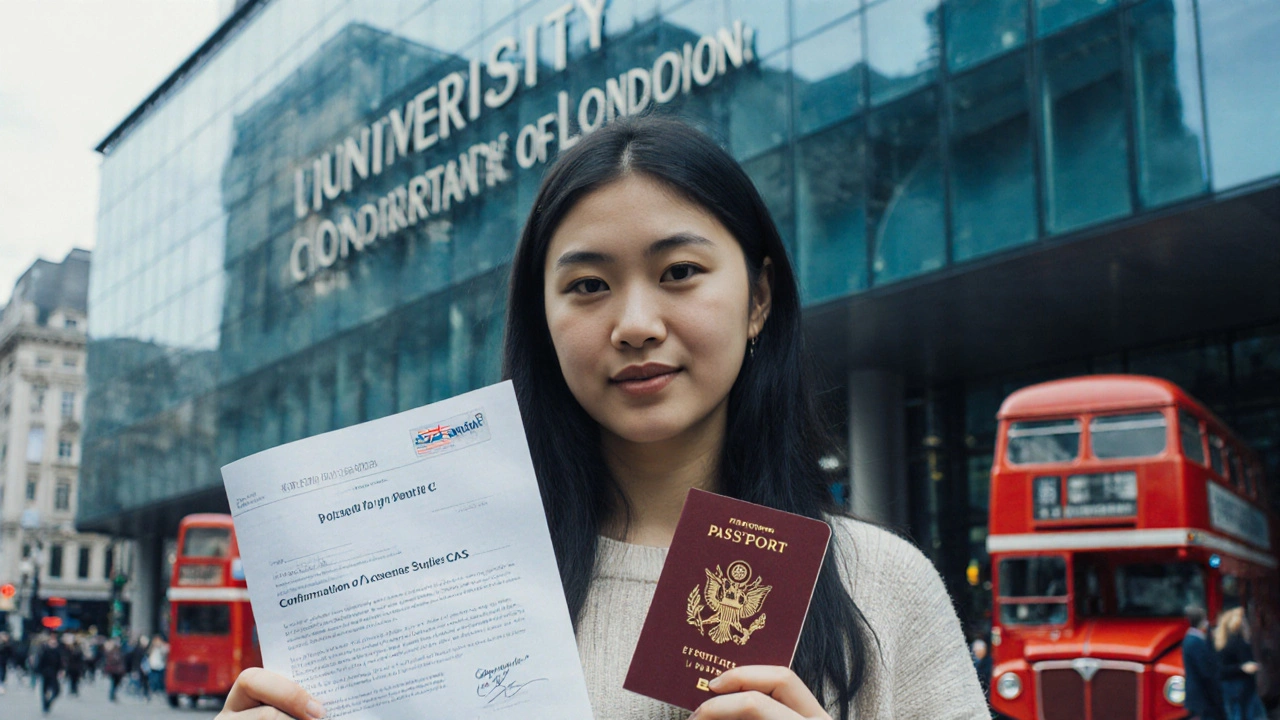
Applying to a university in the UK from another country can feel overwhelming. You’re not just filling out forms-you’re navigating a new education system, different deadlines, visa rules, and cultural expectations. But it’s not as complicated as it looks. Thousands of students from over 180 countries get into UK universities every year. With the right steps, you can too.
Start with UCAS: The Central Application System
All undergraduate applications to UK universities go through UCAS (Universities and Colleges Admissions Service). It’s the only official portal for international students applying for bachelor’s degrees. You don’t apply directly to each university. Instead, you pick up to five courses-any mix of universities and subjects-on one form.
Unlike some countries, the UK doesn’t have separate applications for each school. That means you can apply to Oxford, Manchester, and Edinburgh all at once. But here’s the catch: you must submit your UCAS application by January 31 for most courses. For medicine, dentistry, and veterinary science, the deadline is October 15. Missing these dates means you’ll miss the cycle entirely.
On UCAS, you’ll need to provide your personal details, academic history, a personal statement, and a reference. Your academic records must be translated into English if they’re not already. If you’re from India, Nigeria, or Brazil, your high school diploma might need a WES or UK NARIC evaluation to prove it’s equivalent to UK A-levels or the International Baccalaureate.
Meet the Academic Requirements
UK universities don’t use GPA the way U.S. schools do. They look at your qualifications in terms of UK equivalents. For example:
- U.S. high school diploma + 3 AP scores of 4 or higher = typical entry requirement
- Indian CBSE or ISC with 75%+ average = competitive for mid-tier universities
- Canadian High School Diploma with 80%+ = accepted by most institutions
- International Baccalaureate with 30+ points = standard for many universities
Top universities like Imperial College London or University College London often require higher scores. For example, Imperial’s engineering program might ask for 38 IB points with 7 in Higher Level Math and Physics. Always check the exact entry requirements on the university’s website-don’t rely on general advice.
If your qualifications don’t match up, you can take a foundation year. These are one-year pre-university courses designed for international students. They’re offered by universities like King’s College London or the University of Manchester, and they lead directly into the first year of a degree if you pass.
Prove Your English Skills
Unless you’re from a majority English-speaking country (like the U.S., Canada, Australia, or New Zealand), you’ll need to take an English language test. The two most accepted tests are IELTS and TOEFL.
Most universities require an IELTS score of 6.5 overall with no band below 6.0. For competitive programs like law or journalism, you might need 7.0 or higher. TOEFL iBT scores are usually accepted too-most universities want 90 or above.
Some universities offer pre-sessional English courses if your score is just below the requirement. These are 4-12 week programs that help you improve your language skills before starting your degree. But don’t assume you can just get in with a low score. If your English is weak, prepare early.
Write a Strong Personal Statement
Your personal statement is your chance to stand out. It’s 4,000 characters-about 47 lines-on UCAS. This isn’t a resume. It’s not a list of achievements. It’s a story.
Start with why you want to study your chosen subject. Did a documentary spark your interest in psychology? Did volunteering at a clinic make you want to study medicine? Be specific. Mention books you’ve read, projects you’ve done, or challenges you’ve overcome.
Don’t say, “I’m hardworking.” Show it. Say, “I spent six months designing a solar-powered water purifier for my school science fair, which won regional recognition.”
International students often make the mistake of writing generic statements like, “I’ve always loved learning.” That doesn’t help. Admissions officers read thousands of these. Make yours memorable by being real.

Get a Strong Reference
Your reference should come from a teacher, counselor, or academic advisor who knows you well. They need to speak to your academic ability, work ethic, and potential for university-level study.
Don’t ask your principal or a coach who barely knows you. Pick someone who can give concrete examples: “She led a group project on climate change that improved recycling on campus,” or “He consistently scored in the top 5% of his class despite working part-time.”
Give your referee at least three weeks’ notice. Provide them with your personal statement, a list of your achievements, and the universities you’re applying to. This helps them write a targeted, strong letter.
Apply for Your Student Visa
Once you get an offer, you’ll need a Student Route visa to come to the UK. You can apply as soon as you receive your Confirmation of Acceptance for Studies (CAS) from the university. The CAS is a unique reference number that proves you’ve been accepted.
You’ll need to show:
- A valid passport
- Your CAS number
- Proof of funds: £1,334 per month for up to 9 months if you’re studying in London, or £1,023 per month if you’re studying outside London
- A tuberculosis test result (if you’re from a listed country)
Money must be in your account (or your parent’s) for 28 consecutive days before applying. Don’t withdraw it after you’ve shown it. The UK government checks this carefully.
Apply online, pay the visa fee (£490), and the healthcare surcharge (£776 per year). You’ll need to book an appointment at a visa center to give your biometrics (photo and fingerprints). Processing usually takes 3 weeks, but can take longer during peak season.
Prepare for Life in the UK
Once your visa is approved, start preparing for life in the UK. Renting housing can be tricky. Most universities offer on-campus housing for first-year international students. Apply early-spaces fill up fast.
You’ll need to open a UK bank account. Some banks let you start the process before you arrive. HSBC and Barclays have international student packages. Bring your passport, visa, CAS, and proof of address.
Understand the cost of living. Outside London, rent might be £600-£800 per month. Food, transport, and bills add another £400-£600. Budget carefully. Part-time work is allowed up to 20 hours per week during term time.
Don’t forget to register with a doctor (GP) as soon as you arrive. The NHS gives you free healthcare as a student, but you need to sign up.

What If You Get Rejected?
Not getting into your first-choice university isn’t the end. Many international students get accepted through UCAS Clearing, which opens in July after A-level results are released. You can search for courses with vacancies and call universities directly.
You can also reapply next year. Use the time to improve your grades, retake your English test, or gain relevant experience. Some students take a gap year and work or volunteer in their home country. That can strengthen your next application.
Another option: start at a university in your home country and transfer later. Some UK universities accept transfer students from other countries, especially if you’ve completed a year of study with strong grades.
Common Mistakes to Avoid
- Waiting until the last minute to start your application
- Using the same personal statement for every course
- Not checking if your qualifications are accepted
- Thinking you can work full-time on a student visa
- Ignoring the visa financial requirements
- Assuming all universities have the same deadlines
The biggest mistake? Not asking for help. Reach out to your school counselor, connect with current international students on LinkedIn, or join Facebook groups like ‘UK University Applicants 2025.’ Real people have been where you are. They can give you honest advice.
Can I apply to UK universities without IELTS?
Yes, but only if you’re from a majority English-speaking country or have completed your prior education in English. Some universities accept proof that your high school instruction was in English, such as a letter from your school. Always check the university’s specific policy.
How long does it take to get a UK student visa?
Standard processing takes up to 3 weeks, but it can take longer during peak months like June-August. Apply as soon as you get your CAS. You can pay for a priority service (2-5 days) if you need it faster.
Can I bring my family to the UK on a student visa?
Only if you’re studying a postgraduate course (Master’s or PhD) that lasts 9 months or longer, and you’re sponsored by the UK government or a full-time overseas government. Undergraduate students cannot bring dependents.
Do I need to take the SAT for UK universities?
No, UK universities don’t require the SAT. They focus on your high school grades, AP scores, IB results, or equivalent qualifications. SAT scores won’t hurt, but they won’t help much unless you’re applying to a very competitive program.
What if my country isn’t on the tuberculosis test list?
If your country isn’t listed by the UK government as requiring a TB test, you don’t need one. Check the official UK government website for the latest list. It’s updated regularly, so always verify before booking your test.
Next Steps
Right now, your next move is simple: open the UCAS website and start your account. Don’t wait for the perfect personal statement. Start drafting. Collect your documents. Contact your teachers for references. Set calendar reminders for every deadline.
The UK doesn’t want perfect applicants. It wants motivated, prepared ones. You’ve already taken the hardest step-you decided to apply. Now, take the next one. One form at a time, one deadline at a time. You’ve got this.